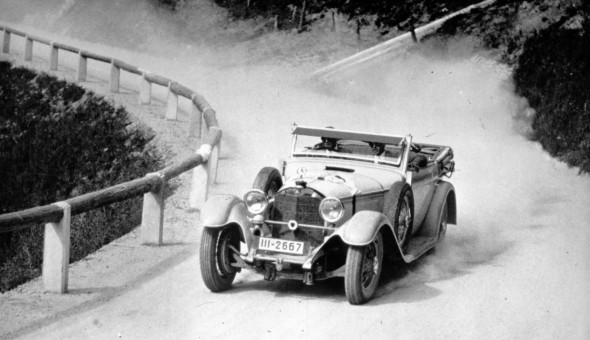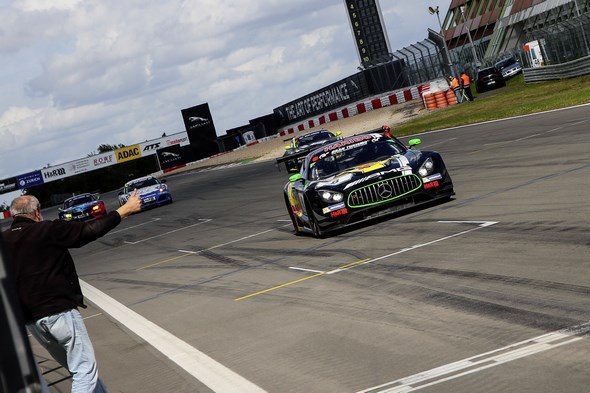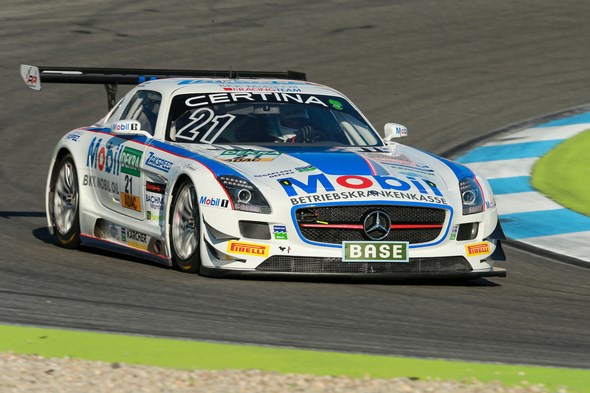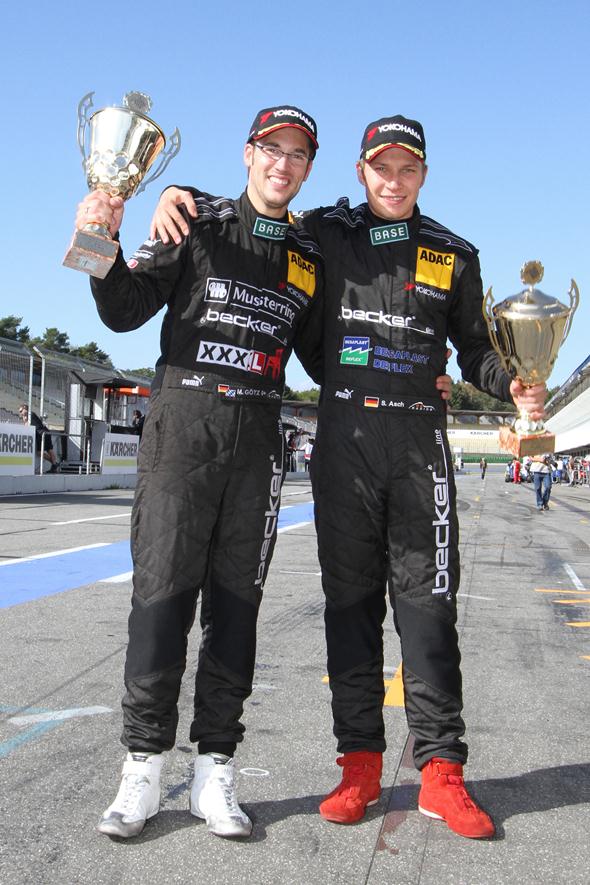K to SSKL: the Mercedes-Benz Kompressor cars

- 1926: debut of Mercedes-Benz Kompressor cars on the racetrack
- Impressive vehicles dubbed ‘white elephants’
- Victory in Mille Miglia 1931 as the first non-Italian winner
Ahead of the merger, Benz and Daimler had agreed that the racing activities of both brands would be continued for the time being by DMG. This was also the background to the focus on the Kompressor vehicles made in Stuttgart in the two years before the 1926 merger, and after the completion of the transaction. Mercedes had already been making racing cars with mechanical superchargers of this kind for some years. The most powerful of those vehicles was the eight-cylinder Monza car of 1924.
It was in one of these cars that Rudolf Caracciola won the first German Grand Prix for sports cars on 11 July 1926, at the Avus track in Berlin. Caracciola completed the distance of 392.3 kilometres with an average speed of 135.2 km/h. In order to race as a sports car, the Mercedes-Benz racing department converted the body of the grand prix design into a four-seater.
While the Monza racing car did not play any major role in the new company’s involvement in motor racing, the first German Grand Prix did mark the beginning of a new era in motor sport. It was at this time that Alfred Neubauer, who now saw himself more as an organiser than a racing driver, first formulated his idea for detailed communication between drivers and the pits with a system of flags and sign boards, and for a meticulously planned process during pit stops. Neubauer first used his communication system in the ‘Solitude’ race on 12 September 1926.
The ‘over five-litre sports car’ class of the Solitude race was won by Willy Walb in his K model, first introduced in 1926. On the very same day, Rudolf Caracciola won the Semmering event, also in a
Mercedes-Benz K, with an average speed of 74.7 km/h, in the class for touring cars with displacement of up to eight litres. Caracciola also won the racing car class, in a 1914 Mercedes 4.5-litre grand prix racing car with a Kompressor supercharged engine. His average speed of 89.8 km/h gave Caracciola another record, and also his third Semmering ‘Wanderpreis’ trophy, which he was therefore entitled to retain permanently.
However, the star of the racing year was clearly the Mercedes K racing touring car based on the Mercedes 24/100/140 hp. This car had a displacement of 6242 cc and developed 110 hp (85 kW) with a Roots mechanical supercharger, or 160 hp (118 kW) with the Kompressor supercharger. The K was the first member of the legendary family of heavyweight Kompressor cars that enabled Mercedes-Benz to dominate the racing scene in the years from 1926 onwards. The K, S, SS, SSK and SSKL models were used for racing events, but were also available for use on the road.
1927: the Mercedes-Benz S model, the first of the ‘white elephants’
The Mercedes-Benz 26/170/225 hp S model racing touring car from 1927 was the first Kompressor sports car in this family to be fully developed by Mercedes-Benz as a racing car. This enhancement of the K racing touring car is regarded as the first of the ‘white elephants’.
This was the somewhat unflattering nickname – at least on first glance – given by the racing community to the heavyweight models from the S to the SSKL, with which Mercedes-Benz totally dominated the racing scene in the late 1920s and early 1930s. These cars, painted in Germany’s traditional white racing colour, were big, strong and powerful – but there the comparison with the mighty beast ended.
In fact, the 1.9-tonne titans with their huge 6.8-litre engines consistently outpaced the competitors’ lighter, more manoeuvrable vehicles. It was in one of these cars, featuring a lower and improved chassis in comparison with the K model, that Rudolf Caracciola became world famous.
This happened on 19 June 1927, when he drove an S model to victory in the ‘over-five-litre sports car’ class of the race marking the opening of the Nürburgring racetrack, ahead of fellow team member Adolf Rosenberger, in the first of eleven overall and class victories that year. There was also plenty of success for other Mercedes-Benz drivers, including a triple victory in the German Grand Prix for sports cars at the Nürburgring over 509.4 kilometres on 17 July 1927, when Otto Merz (overall winner), Christian Werner and Willy Walb, all driving Mercedes-Benz S cars, dominated the race in the class for sports cars with displacement exceeding three litres.
In 1927, the Daimler-Benz works entered vehicles in more than 90 races and other motor sports events, resulting in countless victories for the K (short chassis) and S (sports) models, in mountain and touring events as well as on the racetrack. The six-cylinder engine of the Mercedes-Benz S, with the supercharger on, developed 180 hp (138 kW) at 3300 rpm.
This enormous power was also coveted by private motorists – a wish that Mercedes-Benz was happy to fulfil. In fact, all the sports cars in this family were also available for non-racing use, becoming the vehicle of choice on the road for affluent male drivers. While private drivers of Kompressor cars also entered numerous racing events, the sophisticated works-built racing versions were reserved for Mercedes-Benz’s own racing drivers.
1928: the Mercedes-Benz Super-Sorts model and its progeny
The engineers and designers continued to work tirelessly on further improving the outstanding design of the S model. The result of these efforts made its debut in 1928, as the Mercedes-Benz 27/180/250 hp SS racing touring car. The extra ‘S’ in the name of the new prestige model stood for ‘super’.
The most important difference from the 1927 car was the new M 06 engine, which replaced the M 9856 in the S model, and was later also used in the SSK and SSKL. The ‘06’ in the engine type number indicates that this engine was one of the first to be developed by the joint forces of the companies merged to create Mercedes-Benz. The 7.1-litre engine developed 180 hp (138 kW) without Kompressor, and 250 hp (184 kW) at 3300 rpm with the supercharger.
The standout successes of the SS model on the racetrack included the triple victory in the German Grand Prix on 15 July 1928 at the Nürburgring, where Rudolf Caracciola won with an average speed of 103.9 km/h, ahead of Otto Merz and the Christian Werner / Willy Walb duo.
Mercedes-Benz also won three victories at the Semmering race in September 1928. Wenzler won the class for touring cars of up to eight litres in a Mercedes-Benz S (average speed 77.4 km/h), Ernst Günther von Wentzel-Mosau headed the field for sports cars up to eight litres in his Mercedes-Benz SS (average speed 83.8 km/h), and Rudolf Caracciola took the competition for racing cars with displacement of up to eight litres with the new Mercedes-Benz SSK. His average speed of 89.9 km/h gave him the best time of the day.
The enthusiasm for mountain events in Germany resulted in the development of the SSK, launched in 1928 (the ‘K’ stands for ‘kurz’, the German word for ‘short’), technically largely identical to the SS model, but with a shorter wheelbase, at 2950 mm instead of 3400 mm, and a shorter body. This made the SSK the perfect vehicle for the narrow, winding mountain roads. Rudolf Caracciola began the 1929 racing reason on a high note for Mercedes-Benz by finishing the inaugural Monaco Grand Prix in third place in a Mercedes-Benz SSK.
That same month, he was the overall winner of the Zbraslav-Jiloviste mountain race in Prague. And in pouring rain, he won the International Tourist Trophy in Ireland with an average speed of 117.2 km/h – all in SSK vehicles.
The over-three-litre sports car category of the Grand Prix des Nations for sports cars raced on the Nürburgring racetrack over 508.7 kilometres in July 1929 was won by the August Momberger / Max Arco-Zinneberg team in a Mercedes-Benz SSK, followed by Willy Rosenstein / Adolf Rosenberger.
Carlos Zatuszek also won the Gran Premio Audax Cordoba in Argentina in October 1929 in the same car. Caracciola was again dominant for Mercedes-Benz in the 1930 racing season in the SSK, with victories including the Zbraslav-Jiloviste mountain race in Prague, the Grand Prix of Ireland in Dublin and the international race for the ADAC mountain record at Schauinsland near Freiburg (in the up-to-eight-litre sports car category). His mountain race victories gave Caracciola the European mountain championship title for sports cars in 1930.
In April 1930, with Christian Werner, he also competed in the ‘Mille Miglia’ 1000-mile race to Rome and back, starting and finishing in Brescia. The German duo finished sixth overall, and won the category for cars with a displacement of up to eight litres.
Caracciola then went on to become the overall winner of this famous long-distance event in spring 1931, in the new Mercedes-Benz 27/240/300 hp SSKL sports car, an enhanced, weight-reduced version of the SSK sports car. The 7.1-litre engine now developed 240 hp (176 kW) without supercharging, and 300 hp (221 kW) with the Kompressor supercharger.
This gave the car a top speed of 235 km/h. Externally, the most characteristic feature of the car consisted of the holes created in various components as a highly effective design measure to reduce weight: holes in the vehicle frame and cross members made the SSKL 125 kilograms lighter than the standard vehicle, so that the sports car weighed in at just 1352 kilograms.
The 1931 season was a success from the outset, with Rudolf Caracciola and assistant driver Wilhelm Sebastian winning the Mille Miglia 1931 race in a Mercedes-Benz SSKL. This was the first time a non-Italian had been the overall winner of the prestigious event.
Caracciola’s memories of the event, recorded in 1934, make impressive reading: “1600 kilometres on dusty country roads, with ravines and steep precipices to left and right… through fearsome corkscrew and serpentine bends, towns and villages, then back to dead straight roads again at average speeds of 150, 160 or 170km/h… for a whole night and into the next day.” The Italian drivers appeared to have a clear advantage – they knew the road, and, since some works teams had entered almost 50 cars in the event, they had mechanics lined up all along the way. Mercedes-Benz could not match such resources.
But Caracciola accepted the challenge: “For sixteen hours I sat at the steering wheel, for sixteen hours we thundered through the length and breadth of Italy, following the slim beam of our headlights through the night, and on its into the dazzling glare of an Italian spring day.”
And so it was that, on 13 April 1931, the first team across the finishing line as the winner of the Mille Miglia was the Mercedes-Benz champion and his co-driver Wilhelm Sebastian, completing the course at the average speed of 101.1 km/h, and setting a new record in the process. The next driver to achieve this feat for the plant in Stuttgart was the British driver Stirling Moss, who won the event 24 years later in a Mercedes-Benz 300 SLR.
Caracciola was now racing in a private team supported by
Mercedes-Benz, since, in 1931, the effects of the international recession meant that the firm was no longer able to support its own racing stable. There, however, the SSKL assigned by Daimler-Benz to its top drivers was clearly a race winner.
That same year, Caracciola also won the Eifel race, the German Grand Prix for sports cars, the international race for the ADAC mountain record at the Schauinsland mountain near Freiburg (ahead of Manfred von Brauchitsch, in a Mercedes-Benz SSKL) and the Avus event – and he again won the Europe mountain championship.
In the 1932 season, the Avus race in Berlin was again won by a private driver with an SSKL – but this time, the car belonged to Manfred von Brauchitsch, who had personally had it fitted with a streamlined body. The design was by the leading aerodynamics expert Reinhard Koenig-Fachsenfeld, and the panel work was carried out by the Vetter firm in Cannstatt.
The substantially improved aerodynamics of the modified SSKL, affectionately dubbed ‘the gherkin’ by its driver, gave the car a higher maximum speed than the works version, and resulted in a victory for von Brauchitsch. He won the race with an average speed of 194.2 km/h, ahead of Rudolf Caracciola, now driving for Alfa Romeo in the absence of a Daimler-Benz works team in the 1932 season.
Von Brauchitsch’s exploit earned him a place in the Mercedes-Benz racing team for 1934. However, the day of the ‘white elephants’ as racing cars was now over. The ‘Silver Arrow’ era, bringing even greater success for Mercedes-Benz than that achieved with the S to SSKL models, was about to begin.



































